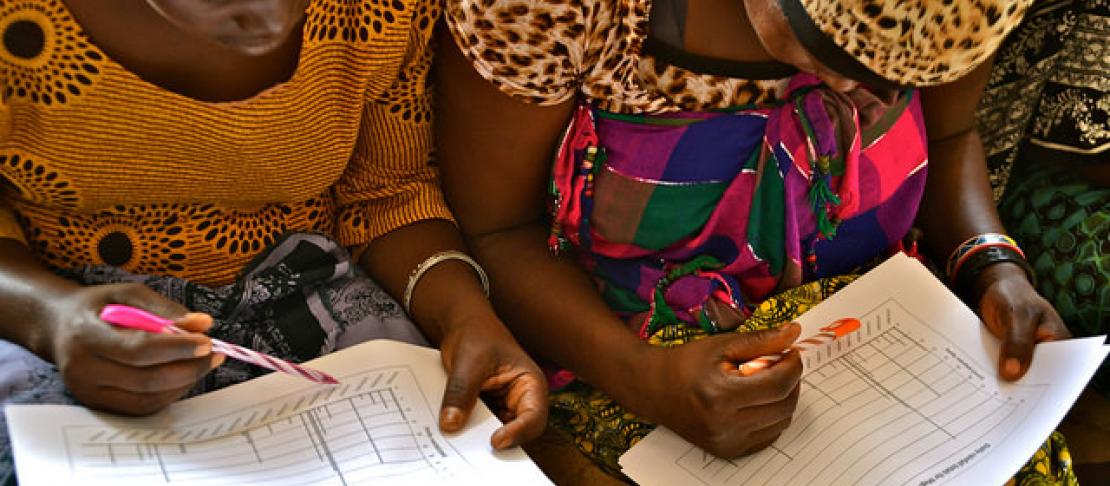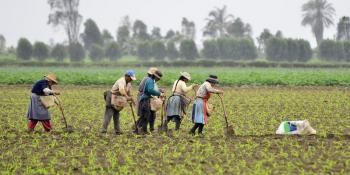Climate Risk Management Special Issue highlights approaches to making climate services more effective for smallholder farmers

A new special issue of Climate Risk Management showcases innovations, insights and evidence from efforts to make climate services work for smallholder farmers.
Six papers in the special issue, Scaling up Climate Services for Smallholder Farmers: Learning from Practice, describe a range of innovative approaches that the CGIAR Research Program on Climate Change, Agriculture and Food Security (CCAFS) projects and partners bring to the challenge of providing effective, locally relevant agricultural climate services at scale, and supporting their use.
Insights and evidence from applied research
Smallholder farmers are aware of climate-related risks and use a range of indicators to anticipate upcoming weather conditions, but the reliability of indigenous climate knowledge has seldom been tested. In the opening article, Climate trends, risks and coping strategies in smallholder farming systems in Uganda, Mubiru et al. compare Ugandan farmers’ perceptions with historical climate records. Also, the describe how the farmers are integrating their indigenous knowledge with modern production technologies to manage climate-related risks.
Despite widespread recognition of the gaps between available services and farmers’ needs, there is little empirical evidence about the degree to which improved climate service practices lead to improved farmer livelihoods and food security. Accordingly, McKune et al. conducted a comparative study across four villages in Kenya and Senegal with differing levels of climate service development (Reaching the end goal: Do interventions to improve climate information services lead to greater food security?). They found the highest rate of climate-smart agriculture (CSA) adoption and best food security status in the location with the most advanced climate services, but did not find a direct relationship between CSA adoption and household food security.

Click here to read the papers.
The next two papers focused on how the rapid expansion of mobile phone penetration in rural areas can support farmers’ management of climate risk. In Mobile-based climate services impact on farmers risk management ability in India, Mittal and Hariharan describe how a pilot mobile phone-based information service increased access to information and awareness of CSA. However, they also discovered that awareness and information were not sufficient to foster widespread adoption of CSA practices. In the fourth paper, Using smart ICT to provide weather and water information to smallholders in Africa: The case of the Gash river basin, Sudan, Amarnath et al. describe a flood-recession farming, or “spate irrigation,” decision-support system. This system translates climate and remote sensing information into predictions of flood extent, water demand, crop biomass production, and irrigation management advisories.
Meeting farmers’ context-specific information needs at scale requires institutional arrangements that bridge the demand and supply sides of climate services, and give farmers a voice in the co-production of services. In the fifth paper, Bridging the gap between climate science and farmers in Colombia, Loboguerrero et al. describe how Local Technical Agro-climatic Committees (LTACs) in Colombia play this role, and enable farmers to improve their management of climate risk.
Smallholder farmers are heterogeneous, and their climate service needs can be quite context-specific. Finally, Carr and Onzere’s evaluation of Mali’s long-standing agrometeorological advisory service (Really effective (for 15% of the men): Lessons in understanding and addressing user needs in climate services from Mali) reveals gender- and age-based obstacles to acting on climate-based advisories, obstacles which arise out of deeply-embedded cultural norms.
Lessons
In their guest editorial, van Huysen, Hansen and Tall highlight several lessons that this diverse body of work supports:
- The potential to make information more useful to farmers by (a) translating raw climate information into agricultural impacts and management options, (b) building on farmers’ perceptions and indigenous knowledge, and (c) engaging a diverse set of stakeholders in the co-production of services;
- Both the potential and the limitations of taking advantage of the mobile phone revolution to support farmer’s management of climate risk;
- The need to show how social norms and inequities may impact climate service needs and impose obstacles to their use; and
- The challenges of evaluating the livelihood and food security impacts of climate services.
Read more:
- Research highlight: Improving women’s access to climate information services will improve their ability to adapt to climate risks
- Research highlight: Rwandan farmers share how climate information helps them improve food security
- Blog: Leveraging climate information services to help farmers cope with climate change in Africa
- Blog: Helping farmers adapt to climate change through climate services
- Research area: Climate information and advisory services for farmers
James Hansen is a senior research scientist at the International Research Institute for Climate and Society (IRI) and CCAFS Flagship Leader on Climate Services and Safety Nets.



